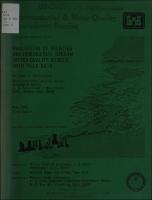Please use this identifier to cite or link to this item:
https://hdl.handle.net/11681/4517Full metadata record
| DC Field | Value | Language |
|---|---|---|
| dc.contributor | Gulf Coast Hydroscience Center (U.S.) | - |
| dc.contributor | Environmental and Water Quality Operational Studies (U.S.) | - |
| dc.contributor.author | McCutcheon, Steve C. | - |
| dc.date.accessioned | 2016-03-16T22:09:45Z | - |
| dc.date.available | 2016-03-16T22:09:45Z | - |
| dc.date.issued | 1983-05 | - |
| dc.identifier.uri | http://hdl.handle.net/11681/4517 | - |
| dc.description | Technical Report | - |
| dc.description | Abstract: Evaluation of the U.S. Geological Survey One-Dimensional Steady-State Stream Water-Quality Model (a modified Streeter-Phelps model), the QUAL II model (Southeast Michigan Council of Governments version), and the U.S. Army Hydrologic Engineering Center's Water Quality for River-Reservoir Systems model indicate that these readily available models for simulating water quality downstream of reservoirs were of comparable accuracy and performed according to their documentation. The evaluation was based on a wide range of accurate steady-state data collected on the Chattahoochee River in Georgia, the Willamette River in Oregon, and the Arkansas River in Colorado. A number of differences exist among these three models; however, each model has the flexibility to make these differences relatively unimportant for typical water quality studies. Each model had minor coding errors which have been corrected. Modeling capabilities are summarized in tabular form to facilitate comparison and selection. Although the modified Streeter-Phelps and QUAL II models are equally valid, different modeling options may make one preferable depending on the specific modeling application. The Water Quality for River-Reservoir Systems model is best limited to dynamic flow and water quality modeling because the data-coding it requires is tedious and involved. However, the wide range of components in that model may be needed for steady-state modeling under special conditions. The capabilities of the Massachusetts Institute of Technology Transient Water Quality Network Model are also summarized for comparison, but that model could not be tested because of program problems; it should not be employed by an inexperienced user until it has been tested and this information updated. The Velz rational technique was not evaluated sufficiently to determine the usefulness of the documentation or its ease of use, but the employment of Chattahoochee and Willamette data in its testing reported in previous studies made it possible to determine that the technique was of comparable accuracy. NOTE: This file is large. Allow your browser several minutes to download the file. | - |
| dc.publisher | Environmental Laboratory (U.S.) | - |
| dc.publisher | Engineer Research and Development Center (U.S.) | - |
| dc.relation | http://acwc.sdp.sirsi.net/client/en_US/search/asset/1036884 | - |
| dc.rights | Approved for public release; distribution is unlimited. | - |
| dc.source | This Digital Resource was created from scans of the Print Resource | - |
| dc.subject | Mathematical models | - |
| dc.subject | Numerical models | - |
| dc.subject | Reservoirs | - |
| dc.subject | Water quality | - |
| dc.subject | Computer programs | - |
| dc.subject | Evaluation | - |
| dc.subject | Comparison | - |
| dc.subject | Field data | - |
| dc.title | Evaluation of selected one-dimensional stream water-quality models with field data | - |
| dc.type | Report | en_US |
| Appears in Collections: | Technical Report | |
Files in This Item:
| File | Description | Size | Format | |
|---|---|---|---|---|
| TR-E-83-11.pdf | 34.35 MB | Adobe PDF |  View/Open |